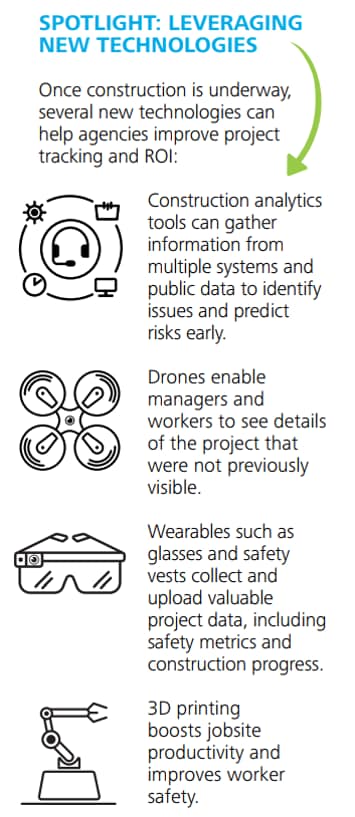Public infrastructure prioritization has been saved

Perspectives
Public infrastructure prioritization
Three strategies to help maximize the impact of government spending
America's infrastructure is aging, requiring significant infrastructure spending to renovate or replace it. It's important for governments to make public infrastructure spending decisions based on obtaining the greatest public good rather than just focusing on selecting projects based on what is politically palatable. New tools like construction analytics can help governments promote and deliver critical infrastructure projects on time and budget.
Explore content
- Infrastructure spending and financial value
- Strategy one
- Strategy two
- Strategy three
- An infrastructure plan in action
Infrastructure spending and financial value
The American Society of Civil Engineers estimates a $2 trillion investment in infrastructure spending will be necessary by 2025 for new and upgraded infrastructure across the country. This eye-opening level of need continues to drive the public sector’s focus on infrastructure projects that produce high levels of financial value and public benefit. Whether receiving funds or financing, these types of projects can be easier to sustain when government leaders apply three infrastructure spending strategies for project selection, financing, and delivery.
Strategy one: Create a portfolio view of projects
Government entities often struggle to develop a complete portfolio view of infrastructure needs, making it difficult to prioritize infrastructure spending across competing projects. Due to this, the projects that proceed are often those with the most powerful political support. In contrast, a portfolio view enables governments to prioritize projects based on factors such as critical need and anticipated economic benefit.
Developing a full view of the infrastructure portfolio is challenging because typically no single agency looks at all infrastructure within a jurisdiction. This means the government or agency cannot optimize overall public infrastructure spending or maximize the use of available federal funding.
However, overcoming the challenge is worth the benefit of having a portfolio view that enables stakeholders to identify the big picture of infrastructure needs and best areas for investment.
Once the portfolio view is in place, the next step is to create a business case analysis for each infrastructure project. The business case should include a quantified scoring of project risks and benefits.
Running comparative analytics on the business case data also helps officials prioritize the projects for planning, funding, and delivery. These analytics encompass cost modeling and an objective assessment of business case factors to identify the projects that will likely achieve the best investment objectives.
Together, the assessments produced by the business case and comparative analytics help decision-makers evaluate tradeoffs and improve resource allocation among projects. These activities also help governments select and prioritize projects in an outcome-focused process that is transparent to the public.
Virginia uses a portfolio-based process to core transportation infrastructure projects. State officials have replaced politically driven wish lists with an objective, data-driven, and transparent decision process, making the best use of limited state funding. Projects are scored and evaluated objectively based on improvements to safety, congestion reduction, accessibility, land use, economic development, and the environment. The criteria for prioritizing projects for infrastructure spending and the scoring results are available to the public online.
"…Overcoming the challenge is worth the benefit of having a portfolio view that enables stakeholders to identify the big picture of infrastructure needs and best areas for investment."
Strategy two: Identifying potential funding and financing

Read more about leading practices in infrastructure investment.
The question of funding has delayed US infrastructure spending on various projects in recent years as governments focus on serving increasing citizen needs with limited growth in budgets. To move forward on infrastructure projects, governments can look to new options for funding such as private global investment funds and private equity markets.
To leverage capital investments from the private sector, federal government infrastructure spending needs to support projects that generate a certain and robust funding stream. In many cases, that funding will require some type of tax increase. A strong business case may help leaders educate the public about the project need and gain support for new taxes, fees, or tolls.
Whether the initial funding comes from a tax levy or private investors, the next step is to arrange the project financing, traditionally by issuing municipal bonds. Future infrastructure projects will increasingly rely on innovative financing, including equity involvement through design/build contracts and public/private partnerships (P3s). Governments can also discover financing options by taking a new look at how project roles, risks, and rewards can be allocated among multiple partners.
Strategy three: Clear a leadership path for project delivery
Governments need to increase public confidence about their ability to deliver an infrastructure project without delays and cost overruns. As a starting point, agency leaders need practical resources and political backing to clear a leadership path for accomplishing the project according to plan.
An ever-growing suite of tools is available to support this path through renewed capabilities for:
- Improving the organizational structure, systems, and controls in planning and managing capital projects
- Implementing alternative procurement practices
- Adopting innovative methods for construction planning and management
These tools, such as construction analytics, can help complete projects faster, with better quality, and at a lower cost. In turn, the success of one project improves public confidence about subsequent projects in the pipeline.
An infrastructure plan in action
Michigan, like most states, is working on its long-term infrastructure planning. To accelerate action on addressing critical infrastructure needs, Governor Rick Snyder created the 21st Century Infrastructure Commission in 2016. In a parallel effort, the CEO roundtable in Michigan, Business Leaders of Michigan, commissioned Deloitte to study the state's infrastructure performance and practices in comparison to other governments, then recommend strategies for improvement and priorities for infrastructure spending.
The study findings should help Michigan leaders across the public and private sectors understand the overall level of infrastructure investment needed, prioritize projects, coordinate project planning and procurement, and explore new approaches to project funding and financing.


